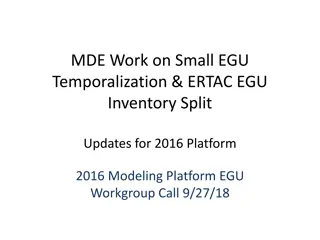
Understanding Array Declaration and Dynamic Arrays in Programming
Exploring the concepts of storing data in arrays and ArrayLists, and the differences between variables and arrays. Learn about main properties of arrays, such as dimensions, boundaries, dynamism, and types, along with examples. Discover how to declare dynamic arrays in programming and essential features like rank, total elements, and lengths of arrays.
Download Presentation

Please find below an Image/Link to download the presentation.
The content on the website is provided AS IS for your information and personal use only. It may not be sold, licensed, or shared on other websites without obtaining consent from the author. If you encounter any issues during the download, it is possible that the publisher has removed the file from their server.
You are allowed to download the files provided on this website for personal or commercial use, subject to the condition that they are used lawfully. All files are the property of their respective owners.
The content on the website is provided AS IS for your information and personal use only. It may not be sold, licensed, or shared on other websites without obtaining consent from the author.
E N D
Presentation Transcript
Introduction to Programming Lecture 5 Msury Mahunnah, Department of Informatics, Tallinn University of Technology
Storing set of data Arrays ArrayLists
Variable vs Array Variable consists of a cell to keep (store) the value, provided with the name Array consists of cells to keep (store) the values, provided with the name and the indexes.
Why? Let s set up an assignment to find maximum salary among the 5 employee. Dim salary1%, salary2%, salary3%, salary4%, salary5% or Dim salaries%(4) Example on the whiteboard!
Main properties 1. Name For names, same rules as variables 2. Dimensions It will determine how the items are organised? 3. Boundaries of indexes Boundaries for every dimension 4. Dynamism Static memory (Dim) and Dynamic memory (ReDim) Dim allocate memory before the work of a program Redim allocate memory during the program work 5. Type Integer, String, Date, Boolean, ... Every property is determined directly or indirecty with an array declaration!!!
Main properties - example Dim A(5) As Integer Name A Dimesions 1 (how many boundaries do we have?) Boundaries of indexes (for first dimension) 0 to 5 Dynamism static (Dim) Type Integer
Main properties - example Dim B( , ) As String Redim B(3, 7) Name B Dimesions 2 (how many boundaries do we have?) Boundaries of indexes for first dimension 0 to 3 for second dimension 0 to 7 Dynamism dynamical (ReDim) Type String
Declaring a dynamic array At first declare it as usual with Dim statement (or Public or Private), but do not specify boundaries for its dimensions: Dim DynArray() As Integer Later in the program, when you know how many elements you want to store in the array, use the ReDim statement: ReDim DynArray(UserCount)
Declaring a dynamic array Dim A( , , ) As Integer ReDim A(3, 7, 4) How to know some essentials features? Dimensions in array A.Rank - > 3 Total elements in array A.Length - > 160 Elements in first dimension A.GetLength(0) -> 4 Elements in second dimension A.GetLength(1) -> 8 Elements in third dimension A.GetLength(2) -> 5 Last index in the first dimension A.GetUpperBound(0) - > 3 Last index in the second dimension A.GetUpperBound(1) - > 7 Last index in the second dimension A.GetUpperBound(2) - > 4
Initializing Arrays General constructor: Dim arrayname() As type = {entry0, entry1, ... , entryN} Two ways to do this (real example): Dim Names() As String = { Peter , Kathy } Dim Names(1) As String Names(0)= Peter Names(1)= Kathy
Initializing Arrays real example Dim Matrix ( , ) As Integer = {{10, 20, 30}, {40, 50, 60}, {70, 80, 90}} 0 1 2 Or 0 10 20 30 1 40 50 60 Dim Matrix ( , ) As Integer = 2 70 80 90 {{10, 20, 30}, _ {40, 50, 60}, _ {70, 80, 90}}
Repeated ReDim declaration Each time you execute the ReDim statement, all the values currently stored in the array are lost!!! Q: But If I need to do it for enlarging an array? A: Use keyword Preserve
Preserve example Dim Vector() As Byte Redim Vector(7) To enlarge Vector: ReDim Preserve Vector (12) Or ReDim Preserve (Vector.GetUpperBound(0)+5)
Initializing array with random number Const max%=3, a%=1, b%=9 random numbers from 1 to 9 Dim V%(max), i% Before (for cycle) -> V={0, 0, 0, 0} For i=0 to max V(i)=Int(Rnd()*(b-a+1)-a) Next i After (for cycle) - > V = {6, 2, 5, 8}
An additional possibility to store data ... The ArrayList Collection ... ... is a dynamical structure Advantages: Adding new items simply Removing items (by index and also by value) Storing there different type of values More convinient - grow automatically as you add elements 1. 2. 3. 4.
The ArrayList Collection Declaration: Dim aList As New ArrayList Adding items: Dim words() As String = {"Just", "a", "few", "words"} aList.Add(words): aList.Add("Hello") aList.Add(777): aList.Add(True)
The ArrayList Collection First item index (sequence number) is 0 Removing items: By value: aList.Remove( Hello ) By index: aList.RemoveAt(2) All items at the same time: aList.Clear()













